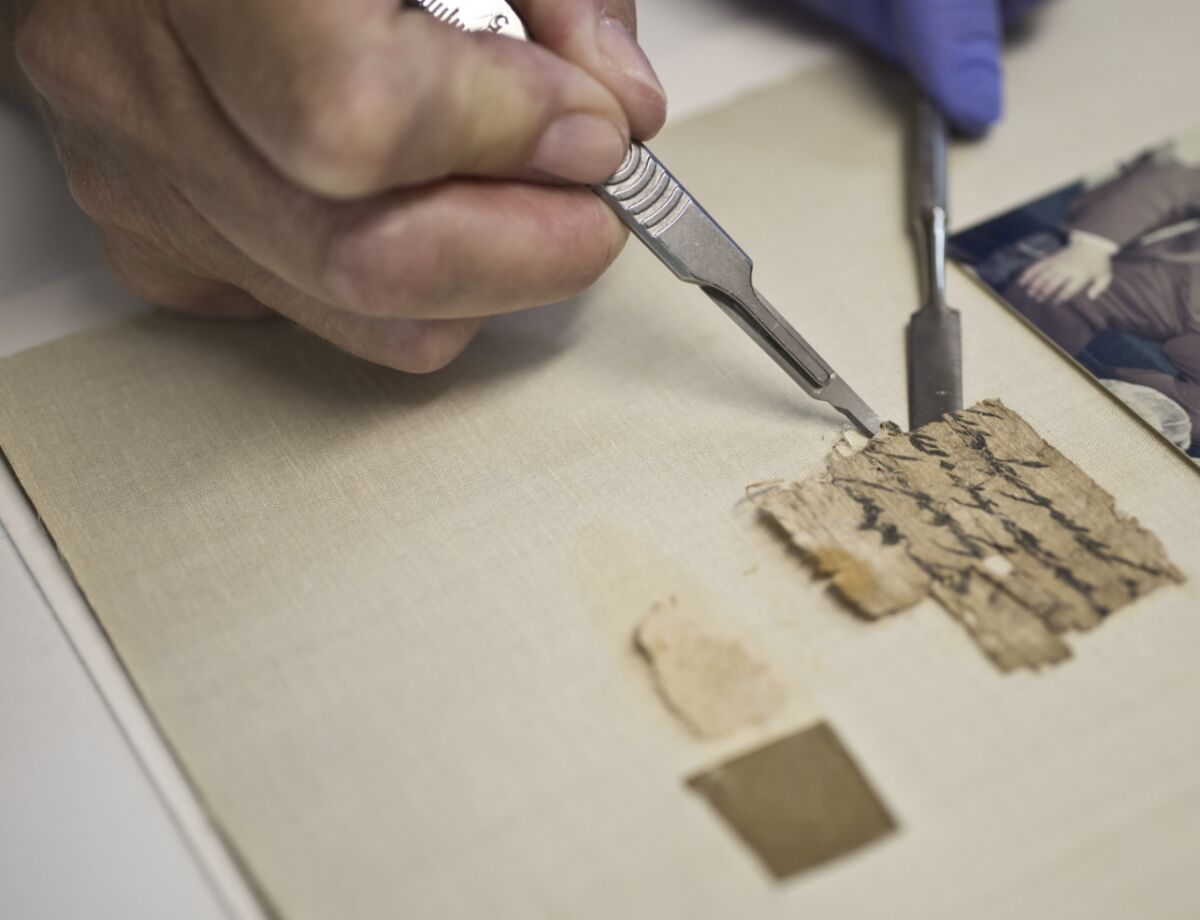The (Re)discovery of the Ishmael Papyrus—One of Only Three Known First Temple-Period Papyri
It’s a remarkable story of one of the rarest inscription mediums from the First Temple period, the hunt for a long-lost text, and the repatriation intelligence operation conducted to bring it back home.

Prof. Shmuel Ahituv of Ben-Gurion University is an Israel Prize-winning, renowned scholar of Israeli archaeology and history who specializes in epigraphy. In 2018, he picked up the mantle of a publication project from the late Dr. Ada Yardeni (who died in June of that year). In the process, he came across a photo of a piece of papyrus that had been looted from one of the Judean desert caves, together with a preliminary decipherment by Yardeni. To that point, it had been an unknown artifact, and there was no information regarding its whereabouts.
Thus began a project in conjunction with the Antiquities Theft Protection Unit of the Israeli Antiquities Authority to hunt down this piece of papyrus.
Long story short, a convoluted domestic search quickly became international and concluded in Montana, where the papyrus’s owner (who wishes to remain anonymous) explained that his mother had gifted it to him after a famous antiquities dealer (Halil Kando, who sold several such Dead Sea Scrolls) and the curator of the Rockefeller Museum at the time (Joseph Sa’ad) had presented it to her during a visit she made to Jerusalem in the 1960s. The papyrus had been framed by his mother and placed on the wall.
After traveling to Israel to see where the item would be conserved and studied in carefully climate-controlled conditions, the individual agreed to turn it over to the Israel Antiquities Authority.

Already, extensive testing has begun on the artifact. When it comes to an item discovered on the antiquities market, there is always an air of doubt surrounding its authenticity (a dubiousness highlighted by epigrapher Prof. Christopher Rollston in a guest post for Times of Israel). Nevertheless, examination of the papyrus has revealed its genuine antiquity, with radiocarbon dating putting it somewhere around the late seventh or early sixth century b.c.e. This matches with Ahituv’s palaeographic analysis of the text style on the papyrus, which also fits nicely into the same time period. During the release of the artifact at the Bible Lands Museum conference on Thursday, Prof. Ahituv rather animatedly dismissed doubts about the artifact’s authenticity based on the above analyses and the now-established chain of custody for the item.
This makes the artifact only the third papyrus known from in or around this First Temple/Iron Age period in the collections of the Israel National Treasures. Papyri were a prime medium of administration in the ancient world. However, due to their organic nature, very few are preserved (unless they are from sheltered, arid desert environments or tombs—hence the preservation of the Dead Sea Scrolls and of various Egyptian texts in such environments). Nevertheless, we know that papyri were the key form of official communication for Israel and Judah during the First Temple period, not least thanks to the papyrus imprints found on thousands of administrative clay bullae/seal stamps.
https://www.youtube.com/watch?v=x6jjwMMYbAs
This artifact is not only significant because of its dating, but also because of its content. The iaa describes the papyrus this way:
The extremely rare document is composed of four torn lines that begin with the words “To Ishmael send …”, the text hinting that it is a fragment of a letter containing instructions to the recipient. Based on the writing, it is proposed to date the “Ishmael Papyrus” to the seventh to sixth centuries b.c.e., joining only two other documents from this period in the Israel Antiquities Authority Dead Sea Scrolls collection. All three papyri come from the Judean Desert, where the dry climate enables the preservation of the papyri.

Given the clipped and extremely cursive nature of the text (a “hasty” correspondence written with a broad stylus, according to Ahituv), only a few other lines can be deciphered, including “don’t send,” “cry after him,” and “of no help.” According to Prof. Ahituv, “The name Ishmael mentioned in the document was a common name in the biblical period, meaning ‘God will hear.’” He elaborated:
It first appears in the Bible as the name of the son of Abraham and Hagar, and it is subsequently the personal name of several individuals in the Bible, including Yishmael ben Netanyahu, who murdered the governor Gedaliah ben Ahikam. It also appears as the name of officials on palaeographic finds such as bullae (clay stamp seals) used for sealing royal documents in the administration of the kingdom of Judah—for example, the bulla reading, “To Yishmael, son of the king.” The present document probably certified a dispatchment either to, or from, Yishmael.
As cited by Ahituv, Jeremiah 40 introduces a man named Ishmael during the same late-seventh to early-sixth century b.c.e. time period. Following Babylon’s conquest of Jerusalem, the region of Judah was put under the control of a governor named Gedaliah son of Ahikam, who ruled from Mizpah. Gedaliah was warned that the royal individual Ishmael was conspiring against his life (verse 14; Jeremiah 41:1). The informant labeled Ishmael as an agent and ally of King Baalis of Ammon (the first Ammonite ruler confirmed by archaeology. Likewise, the biblical identification of Ishmael as “of the seed royal” may fit nicely with the “Ishmael, son of the king” bulla of the same period). Gedaliah dismissed the accusations as libel (Jeremiah 40:16).
https://twitter.com/Chris_K_Eames/status/1450839651313455114
Jeremiah 41 describes Ishmael and a small band of his confreres slaying Gedaliah. A brutal slaughter of Gedaliah’s supporters followed, after which Ishmael began to drive a large deportation of Jews into Ammon. Ishmael’s insurrection was bloody, but also brief. The commander Johanan amassed a force against Ishmael, routing him and his men and rescuing the captives.

Could this letter, dating to the same period and fitting with the general geographic picture, have been addressed to this Ishmael, regarding his directive from the Ammonites to “send” Jewish captives? Of course, we can only speculate.
In sum, the Ishmael Papyrus gives a remarkably rare insight into the use of First Temple-period papyrus in Judah. And whether or not it attests to this famous “Ishmael” of the Bible, it certainly corroborates the use of that name at the time and in this eastern desert region.